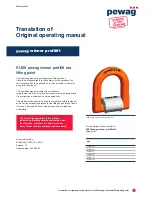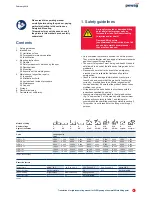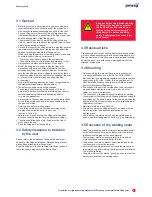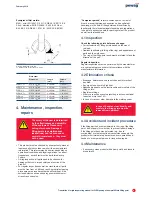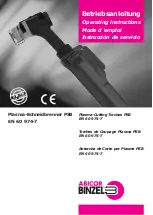
3
Translation of original operating manual for PLEW pewag winner profilift eta lifting point
February 2018
2. Intended use
Purpose:
The pewag PLEW is a lifting point that is welded
onto loads so that lifting chain components (hooks, shackles,
straps...) may be attached to enable the load to be lifted.
Lashing:
The lifting points may also be used as lashing
points. In this case, the admissible lashing capacity is twice
the nominal load capacity. LC in daN = 2x load capacity in kg
(e. g. nominal load capacity of 4000 kg for lifting ->
8000 daN admissible lashing capacity). This product may
only be used for lifting or lashing. Once a lifting point has
been used for lashing, it may no longer be used for lifting
(and vice versa).
Load:
Loading must always take place in the stated direction
(fig. 1) with the maximum load capacity according to
table 1 and taking into consideration the operating conditions
as specified here.
Operating temperature:
The long-term permitted ambient temperature must be
between -20 °C to 200 °C. Outside this range, the reduction
factors according to table 2 must be taken into account.
Impacts:
The lifting point is designed to withstand impacts
resulting e.g. from acceleration when lifting and lowering
loads.
Other:
Use only original parts for the assembling of the
lifting point. Please note the reduction factors as specified in
table 2. The ring is 180° foldable and must be aligned in the
direction of the pull before loading.
Markings at 45° and 60° simplify the estimation of the angle
of inclination of chain slings and therefore the permitted
directions of pull.
2.1 Limitations of use
• PLEW lifting points are not to be used in areas
with highly corrosive influences (e.g. sewage or chemicals
etc.). They must not be exposed to acids and alkalis or
their fumes. Please consult our technical service on advice
for using the products in aggressive environments.
• The lifting points must not be used over edges or corners.
• Ring must not be folded up and down continuously while
under load.
• This product must not be used for the lifting or securing
of persons.
• If the load distribution is asymmetrical (unequal angle of the
legs of the lifting gear), count only 1 leg as bearing.
Fig. 1: Permissible pull directions that occur when used correctly.
180°
The information provided in this
operational manual assumes the
absence of particularly dangerous
conditions. Particularly dangerous
conditions include offshore operations
and nuclear contaminated areas.
In such instances, the permissibility
and the degree of danger must be
discussed with pewag.
2.2 Foreseeable improper operation
• Operation by unskilled persons.
• Operation by persons who do not understand the language
used in this manual and therefore do not fully understand
what they are reading.
• Attachment to objects for which no instruction manual or
strength verification is present or available
• Attachment of lifting devices for which no instruction
manual or inspection based on applicable standards is
present or available.
• Welding performed by persons who have not passed the
test required by applicable standards.
• Use of filler metals other than those specified in this
instruction manual.
2.3 Identification
Each pewag PLEW lifting point has been stamped with
the maximum load capacity for adverse load distribution,
manufacturer and batch identification. Fig. 2 shows the exact
identification details on the product.
3. Mounting Instructions
Fig. 2: Component description and location of identification details on product.
Load capacity
(WLL)
Batch number
Marking DGUV/BGR
Front side
Back side
Manufacturer
Ring
Batch
number
Weld on block
Product family
Serial number
CE-Marking
Identification on weld on block
Groove
raised
45°
Groove
deepened 60°

